
System 100
System 300
1002/1020
1003 Sonic Carrier
Wavecomputer 340
350 Sequencer
Wavecomputer 360
Wave 2.0
Wave 2.2
Wave 2.3
Waveterm A/B
390 Drum Unit
Wave 2.V
F.A.Q.
PPG CD-ROM
PPG Mail List
Misc
Events
Downloads
Links
Paul.Maddox
 Synth.net
Synth.net
Sounds
Bell
Choir
Vocal Hit
Clunk
Hyper-Twang
Table Sweep
Mellow Sweep
Bright Sweep
PolySynth
Detune
Thin reso
Twangy
X-Files
Stereo Pad
Synth Choir
Wave 2.2
The founder of a NEW sound
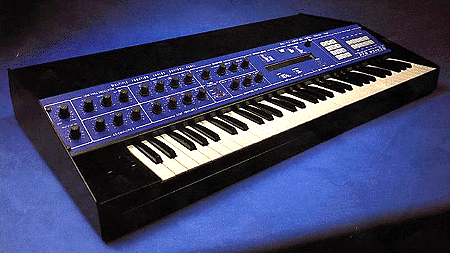
8 Voice polyphonic, 2 Oscillators per voice, SSM filters , sequencer, editing of wavetables via WaveTerm A (or B) and plays samples from WaveTerm A.
This was the synth that started my obsession with wavetable synths. The sound is quite unique and can be very distinctive but can blend into the background and sound much like most other polysynths if you should desire it.
The concept of wavetables can be quite hard to grasp so I shall attempt to explain it simply. Imagine if you will you have a 'normal' oscillator. you have a single waveform or maybe a choice (saw, square, sine). Now imagine you have 64 waveforms and imagine you can change these in real time via an EG, or velocity or mod-wheel, after-touch, etc. This is basically what wavetable synthesis is. You have a 'table' of waveforms which you can move through via various methods. Add to this you have 32 tables each containing 64 waveforms that you can sweep through you get well over 2000 waveforms. Two oscillators you can de-tune to give a depth to the sound and the almost infamous SSM2044 filter chips and you have a unique sounding synth.
Used by the likes of Tangerine Dream, Thomas Dolby, Gary Numan , Frankie Goes To Hollywood and many more. The down side of these great beasts was they didn't take kindly to being moved and consequently earned a reputation that would scare any roady when the key player would say "I wanna take my PPG with me".
These babies were NOT cheap when they came out in 1982, about £5000.00 and for this reason became many a childs' dream synth (certainly did it for me when I listen to Logos)
Heres some technical info about the way these things work.
The wave 2.2 uses digital waveforms stored in a table to create its unique sound. When you call up a table on the main display it fetches from its ROM some half-cycle waveforms and places them in the SRAM (6164's) and then calculates the rest of the intermediate waveforms. This has two HUGE benefits - (1) It saves on space, think about it for a moment 32 tables, 64 waves per table, 128 samples per wave, would be 256Kbyte of ROM alone, EPROMs were expensive at the time. (2) It means the system can be made more flexible via software and a special buss that enables you to download samples into it (via the waveterm). This was a big plus, the only other sampler at the time that was of any calibre was the Fairlight CMI and this was expensive.
Now how do you playback waves from the ram? well, you need the ram and play back the data through a DtoA convertor. and so these leads to the next problem, if you playing a high note , say a high A, this would mean that waveform is coming out at a frequency of 3.5Khz, but remember we need to playback 128 samples in the same time, so you need to playback the ram to get a waveform at a shade over 450Khz. At the time VCO's were not good enough to get this high and certainly not stable enough. So what the PPG did was to use a phase accumulator oscillator. Its a fairly simple concept.. Take a number (we'll call it PTC) and add it to another number (we'll call this one ACC). then store the result in ACC, so it looks like this;-
ACC=ACC+PTC
Now the clever bit.. make ACC a 20Bit number (this means we can have a maximum of 1048576), and take the top 7 bits as your wave counter. you can see that if you set PTC to be 1 then it would take over million clocks to get ACC up to its full value, this would be over one second for a full cycle of a waveform. Now if we set PTC to 8191 and again add 1Mhz it only takes 127 addition to reach the maximum count possible in ACC, this is 7.8Khz, so for a constant clock speed, we can vary the speed over a huge range and with a great accuracy. by juggling with the frequency and number of bits you can increase accuracy and range.
Now to do this polyphonically you need an separate ACC and PTC for each voice. In the PPG we have 8 note polyphony but we have 2 osc's per voice.. so we need 16 ACC and PTC registers (or areas in RAM). The PPG uses a 74S189 which is a 4 bit 16word scratch pad SRAM, so we can store 16 numbers, 4 bits in length... put several of these together, throw in a few adders (74LS283) and something to control the rate of the adding (74LS379) and bingo, you have 16 phase accumulator oscillators waiting to run. The Waldorf wave range use the same principle but instead of discrete logic they use a custom built chip (designed by Wolfgang Palm, creator of the PPG range funnily enough). Here is a pic of the 'PROZ' board which holds the Phase accumulator oscillator and the waveram.
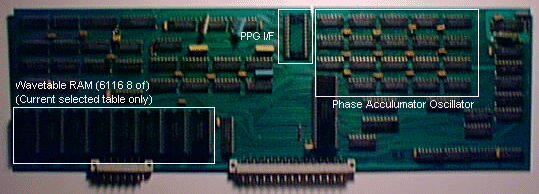
This output was used , in-conjunction with the micro processor) to produce the output which was fed into a DtoA convertor and then into the SSM2044 filters and a CEM VCA section. The EG's on the wave range are generated by the micro processor and again fed into a DtoA to control the SSM and CEM chips. Now for 8 note polyphony we need 8 filters and 8 VCAs, these were mounted on two identical boards in the PPG, here's a close up of one.
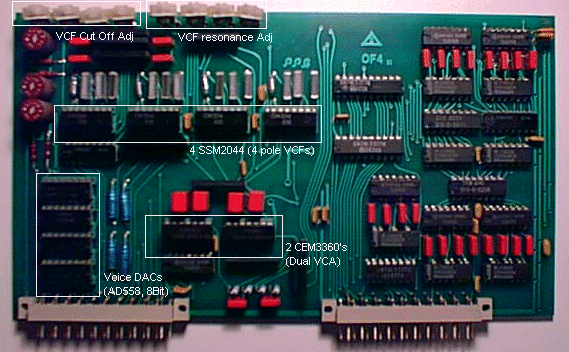
The 8 preset at the top adjust the resonance and Cutoff for each voice.
Here is a pic of the micro processor board, showing the EPROMs and micro (6809). This one also has had midi added, probably at the factory , hence the 'daughter' board mounted where there would have been a single chip. This board also holds the RAM and battery that store your sounds.
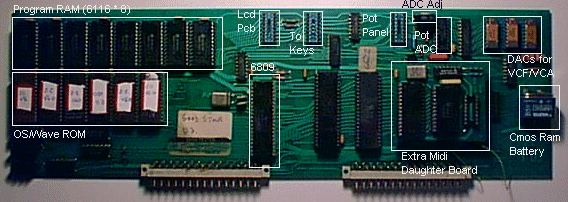
Add to this a Keyboard, a panel, a display and of course a case and you have a complete synthesizer. Heres a shot of the four boards (Micro, PROZ and 2 voice) in their correct slots, showing ribbon cables for Midi/LCD/Panel and Keyboard, as you can see its not a pretty sight but its a lot neater than a lot of polysynths you'll come across.
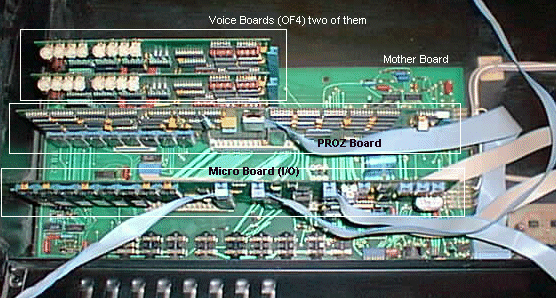
Now after this version (2.2) came the 2.3 which was multitimbral and could also hold more 'samples' in ram ready for use, the boards in these are almost the same, In concept and in the way they work , But are different. The PROZ board had a better resolution and more ram, the micro board had more ram again and a different program in its Rom and the Voice boards had 12Bit DAC's and not 8 like the 2.2